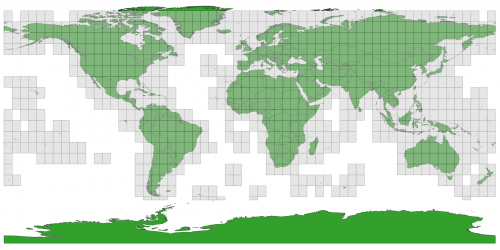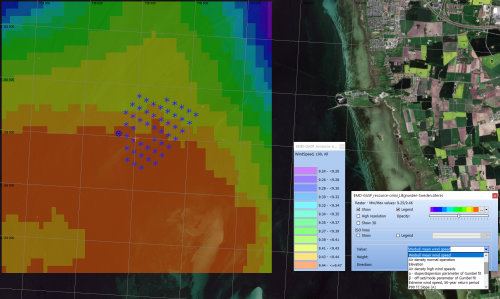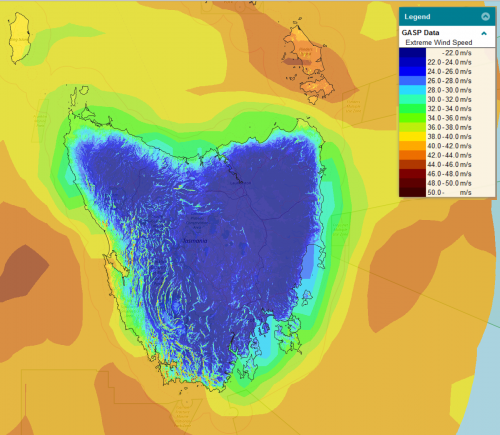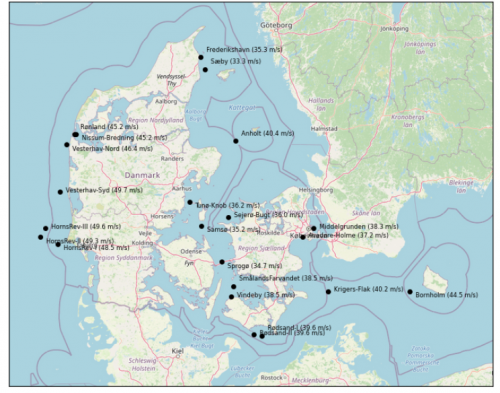GASP Global: Difference between revisions
| Line 32: | Line 32: | ||
== Parameters and Dimensions == | == Parameters and Dimensions == | ||
As seen from the tables below, a very wide range of omnidirectional and sectorwise parameters are available from GASP. These parameters are divided into four main categories: | As seen from the tables below, a very wide range of omnidirectional and sectorwise parameters are available from GASP. These parameters are divided into four main categories: | ||
* Wind Resources / Atmospheric Parameters | |||
* Siting Parameters – Fatigue | |||
* Siting Parameters – Extremes | |||
* Turbine Design Classification - with recommended turbine class. 3 separate aeroelastic models are used as representative for the 3 heights | |||
** 50m: WindPACT 1.5MW | |||
** 100m: NREL 5MW | |||
** 150m: DTU 10MW | |||
The tables below provides an overview of all parameters available and at which dimensions that they are available. We have used the following dimensions for the GASP parameters: The first four (longitude, latitude, height and sector) are used for the basic parameters; the last three (ws_class, iec_class and turbine_component) are used for the turbine design classification - and are releated to the IEC61400-1 code and the aeroelastic load model. Please note that not all dimensions are relevant or used for every GASP parameter. | The tables below provides an overview of all parameters available and at which dimensions that they are available. We have used the following dimensions for the GASP parameters: The first four (longitude, latitude, height and sector) are used for the basic parameters; the last three (ws_class, iec_class and turbine_component) are used for the turbine design classification - and are releated to the IEC61400-1 code and the aeroelastic load model. Please note that not all dimensions are relevant or used for every GASP parameter. | ||
{| class="wikitable" | {| class="wikitable" | ||
Revision as of 16:01, 7 September 2021

Introduction
"GASP Global" is short for "GASP 1.0 - Global of Atlas of Siting Parameters". It is released with windPRO 3.5+ as a global atlas dataset with the following key features:
- Global 250m wind resources, siting parameters & turbine design classification
- Builds on DTU GWA (Global Wind Atlas) datasets and EMD's Load Response technology
- A joint project by EMD and DTU
Dataset Overview
- Spatial coverage:
- Onshore: Near global (all land areas from N80 to S58)
- Offshore: Areas are covered up to 200 km from the coastline
- Resolution:
- Horizontal: 250m in grid resolution
- Vertical: 50m, 100m and 150m as vertical levels
- Data-type: Atlas
- Coordinate system: Geographical coordinates (EPSG: 4326) in original data
- Version: 1.0
Validation and Usage Notes
- How accurate is your resource prospecting based on GASP data in windPRO or windPROSPECTING?
We have prepared a small validation note - based on data from 241 high quality meteorological towers - that gives you a first hint on bias and uncertainty - read more - HERE. - Need turbulence intensity instead of the GASP windspeed standard deviation?
We have prepared a small pdf that describes how to convert from wind speed standard deviations to turbulence intensities - and how to use the two model parameters (A) and (B) to derive the turbulence intensity at any wind speed - read more - HERE.
Availability from EMD's software



- windPRO: In 'Data' menu click 'Siting parameters (GASP etc)' to access the download tool. Data is loaded into a result layer with a .siteres file acting as the data-container.
- The .siteres file can be used in PARK, Site Compliance, Load Response and Optimization calculations.
- windPROSPECTING: GASP data is available through the data-tab named 'Site-prospecting'. Free access to windPROSPECTING - here.
- windprospecting offers spatial view of omnidirectinal parameters and detailed point-data with directional results and statistics.
- EMD-API: Read more at the dedicated wiki-page for our Global Atlas Data Services - here. If you are accessing the GASP data from within the EMD-API, you will use the parameter group-names in order to request specific data-packages [resource-omni, resource-sector, siting-extremes, siting-fatigue-omni, siting-fatigue-sector, turbine-fatigue, turbine-fatigue-recommend, turbine-extreme, turbine-extreme-recommend].
Parameters and Dimensions
As seen from the tables below, a very wide range of omnidirectional and sectorwise parameters are available from GASP. These parameters are divided into four main categories:
- Wind Resources / Atmospheric Parameters
- Siting Parameters – Fatigue
- Siting Parameters – Extremes
- Turbine Design Classification - with recommended turbine class. 3 separate aeroelastic models are used as representative for the 3 heights
- 50m: WindPACT 1.5MW
- 100m: NREL 5MW
- 150m: DTU 10MW
The tables below provides an overview of all parameters available and at which dimensions that they are available. We have used the following dimensions for the GASP parameters: The first four (longitude, latitude, height and sector) are used for the basic parameters; the last three (ws_class, iec_class and turbine_component) are used for the turbine design classification - and are releated to the IEC61400-1 code and the aeroelastic load model. Please note that not all dimensions are relevant or used for every GASP parameter.
| Dimension | Abbreviation | Unit | Range |
|---|---|---|---|
| longitude | lon | deg | 180 to -180 |
| latitude | lat | deg | 90 to -90 |
| height | h | m | 50,100,150 |
| sector | s | deg | 0,30,...,330 |
| ws_class | wcl | I,II,III,T | |
| iec_class | iecc | IA+, IA,...IIIC | |
| turbine_component | tc | 0,1,2,3 |
Parameters: Wind Resource
The two tables below show the GASP parameters for wind resource data divided in omnidirectional data [resource-omni] and sectorwise data [resource-sector].
| Variable | Description | Unit | Dimensions |
|---|---|---|---|
| weib_A | Wind distribution: A (Scale) parameter in Weibull distribution | m/s | lon, lat, h |
| weib_k | Wind distribution: k (shape) parameter in Weibull distribution | lon, lat, h | |
| wsp | Wind speed - annual average | m/s | lon, lat, h |
| wpd | Wind power density – annual average | W/m2 | lon, lat, h |
| air_dens | Air density (annual mean/average) | kg/m3 | lon, lat, h |
| Variable | Description | Unit | Dimensions |
|---|---|---|---|
| weib_A | Wind distribution: A (Scale) parameter in Weibull distribution | m/s | lon, lat, h, s |
| weib_k | Wind distribution: k (shape) parameter in Weibull distribution | lon, lat, h, s | |
| sector_freq | Wind distribution: Sector frequency | lon, lat, h, s | |
| wsp | Wind speed - annual average | m/s | lon, lat, h, s |
| wpd | Wind power density – annual average | W/m2 | lon, lat, h, s |
| air_dens | Air density (annual mean/average) | kg/m3 | lon, lat, h |
| elevation | Air density (annual mean/average) | kg/m3 | lon, lat, h |
Parameters: Siting Classification - Wind Extremes
The table below shows the GASP parameters for the extreme event data [siting-extremes]. Please note that this extreme data is only available as omnidirectional parameters.
| Variable | Description | Unit | Dimensions |
|---|---|---|---|
| air_dens_p98 | Air density at 98th percentile of wind speed | kg/m3 | lon, lat, h |
| wsp_50yr | 50yr extreme wind speed: Average | m/s | lon, lat, h |
| gumbel_alpha | 50yr extreme wind speed: Gumbel distribution – alpha parameter | m/s | lon, lat, h |
| gumbel_beta | 50yr extreme wind speed: Gumbel distribution – beta parameter | m/s | lon, lat, h |
Parameters: Siting Classification - Wind Fatigue Parameters
The two tables below show the GASP parameters for the siting-fatigue parameters - given either omnidirectional or sectorwise data-requests [siting-fatigue-omni, siting-fatigue-sector].
| Variable | Description | Unit | Dimensions |
|---|---|---|---|
| shear_exp | Wind shear exponent (calculated using LINCOM model) - Mean | lon, lat, h | |
| flow_inc | Flow inclination (calculated using LINCOM model) | deg | lon, lat, h |
| terrain_ic | Terrain complexity as defined in IEC 61400-1 standard (ed 4) | lon, lat, h | |
| sigma_P90A[1] | Turbulence slope parameter from IEC 61400-1 (ed4) – P90 | lon, lat, h | |
| sigma_P90B[1] | Turbulence offset parameter from IEC 61400-1 (ed4) – P90 | m/s | lon, lat, h |
| sigma_P90U15 | Turbulence P90 at a fixed windspeed of 15 m/s | m/s | lon, lat, h |
| air_dens | Air density (annual mean/average) | kg/m3 | lon, lat, h |
| Variable | Description | Unit | Dimensions |
|---|---|---|---|
| shear_exp | Wind shear exponent (calculated using LINCOM model) - Mean | lon, lat, h, s | |
| flow_inc | Flow inclination (calculated using LINCOM model) | deg | lon, lat, h, s |
| sigma_meanA[1] | Turbulence slope parameter from IEC 61400-1 (ed4) – Mean | m/s | lon, lat, h, s |
| sigma_meanB[1] | Turbulence offset parameter from IEC 61400-1 (ed4) – Mean | m/s | lon, lat, h, s |
| sigma_P90A[1] | Turbulence slope parameter from IEC 61400-1 (ed4) – P90 | lon, lat, h, s | |
| sigma_P90B[1] | Turbulence offset parameter from IEC 61400-1 (ed4) – P90 | m/s | lon, lat, h, s |
Parameters: Turbine Design – Loads
The four tables below show the GASP parameters for the turbine design classification. The two main groups are fatigue and extreme load cases, divided into four data-groups so requests is possible for turbine load indexes and iec class recommendations: [turbine-fatigue, turbine-fatigue-recommend, turbine-extreme, turbine-extreme-recommend].
| Variable | Description | Unit | Dimensions |
|---|---|---|---|
| flsidx | Load index for the fatigue limit state | % | lon, lat, h, iecc, tc |
| flsidx_w | Load load index for the fatigue limit state with wakes | % | lon, lat, h, iecc, tc |
| tc_woehler | Turbine component (tc): Wöhler exponent used | lon, lat, h, iecc, tc | |
| tc_name | Turbine component (tc): Name | lon, lat, h, iecc, tc | |
| tc_sensor | Turbine component (tc): Sensor name | lon, lat, h, iecc, tc |
| Variable | Description | Unit | Dimensions |
|---|---|---|---|
| iecr_fls_id | IEC Class Recommendation – fatigue limit state (FLS) - id | lon, lat, h | |
| iecr_fls_txt | IEC Class Recommendation – fatigue limit state (FLS) - text | lon, lat, h | |
| iecr_flsw_id | IEC Recommendation (with wakes) – fatigue limit state (FLS) - id | lon, lat, h | |
| iecr_flsw_txt | IEC Recommendation (with wakes) – fatigue limit state (FLS) - text | lon, lat, h |
| Variable | Description | Unit | Dimensions |
|---|---|---|---|
| ulsidx | Design load index for ultimate limit state (ULS) | % | lon, lat, h, wcl |
| Variable | Description | Unit | Dimensions |
|---|---|---|---|
| iecr_uls_id | Design load index for ultimate limit state (ULS) | lon, lat, h | |
| iecr_uls_txt | IEC Class Recommendation – ultimate limit state (ULS) – text | lon, lat, h |
License and Attribution
The data is available through a Creative commons 4.0 by attribution license (CC BY 4.0).
Please accept the license conditions and use a proper attribution when using this dataset, such as:
GASP 1.0, by EMD and DTU, is a free dataset accessible via windprospecting.com, windPRO and EMD-API.
Acknowledgement
- GASP is the result of a BIG collective effort by many people at: EMD International A/S & DTU Wind Energy, with overall project manager Xiaoli Larsén (DTU)
- Develoment and integration of this dataset into EMD services was done through the GASP project which is co-funded by the EUDP and the Danish Energy Agency
External Links & References
- GASP Project Home-Page at DTU - here
- A peer-reviewed paper is being prepared and will be referenced here as the main reference for the GASP methods and technologies